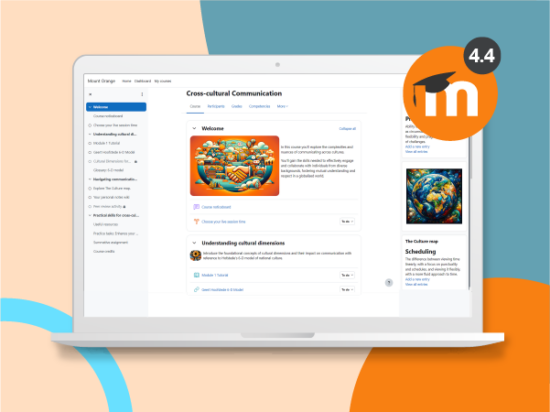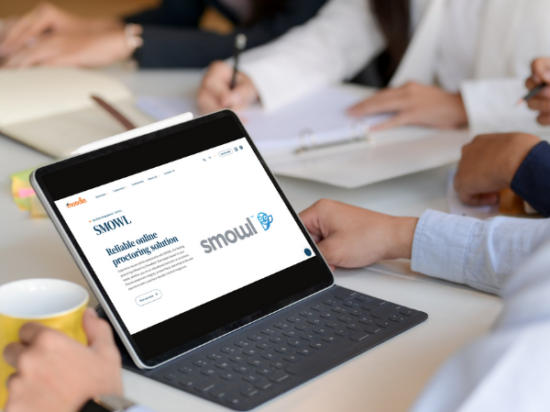Congratulations, you’re hired!
A good HR manager knows that what comes next — new employee onboarding — can be crucial to ensuring both the immediate and long-term success of employees. By adopting an enterprise learning management system (LMS) as part of your approach, you can gain a powerful tool in efficiently helping new workers take the first steps toward realising their potential.
Here are some tips on how to create an effective online employee onboarding experience.
Make it engaging
For new employees, an onboarding programme is often their first sustained impression of your company — and first impressions count!
Create immersive learning experiences
Just because onboarding is required doesn’t mean it needs to be boring and uninspiring. Be sure to create content that is visually appealing and rich with activities requiring learners to actively engage with the learning content and each other in various modalities.
Instead of asking learners to simply consume text or rich media, promote interaction through activities such as quizzes, surveys, games, and peer discussions. Moodle Workplace includes native support for H5P, an open source platform for authoring a variety of interactive content, and it also supports gamification options that can motivate users with leaderboards and prizes.
Reward progress
Instead of requiring learners to complete one long onboarding course, consider breaking it up into smaller chunks. In Moodle Workplace, you can create a training pathway or programme with a sequence of courses, so learners get several positive indications of progress and clearly see what they’ve accomplished and what is left to do. Creating a sequence can also help frame the structure of your content, so your learners better understand what is expected of them.
Track your learners
To best support new employees in their onboarding journey, you need to understand how they progress with the learning content. Moodle Workplace provides a SQL-based report builder, powerful but easy to use, to generate a variety of learning analytics to help managers adapt and improve learning programs to drive better employee performance. The platform also supports the ability to create custom dashboards that can collect reports and be assigned to users by job or role.
Engage your learners with feedback
No matter how insightful your reports, they won’t mean much if you’re not proactive about connecting with new employees in their first weeks at your organisation. Try to create several touch points along their onboarding journey, and determine which performance metrics might warrant an intervention. The dynamic-rule automation in Moodle Workplace, for example, lets you create a variety of automated notifications triggered by learning progress and other factors.
LMS + HRIS = better onboarding
If your company utilises a human resources information system (HRIS), then integrating it with your eLearning software can add another level of efficiency and ease to your onboarding efforts: the HRIS can communicate with the LMS to provide key information about the new employee to help tailor the onboarding experience, while the LMS can likewise communicate the employee’s onboarding activities and performance to the HRIS.
Keep in mind that an LMS integration of this kind often requires a lot of planning, as well as input from many stakeholders. Some initial questions to ask are:
- What will the integration let us do? When considering two enterprise systems such as an LMS and HRIS, there is often not a single kind of integration, but instead many potential integrations. Deciding what is best for your company usually depends on articulating the specific workflows the integration needs to support.
For example, should the addition of a new employee in your HRIS automatically create a new corresponding user account in the LMS? If an employee is promoted or leaves the company, how is that status reflected in the LMS? Should learner progress in the LMS be sent to the HRIS? If so, how should it be presented, and who should see it?
- In what direction will data flow? This question is directly tied to the first. Some companies are only concerned about automating user account creation and syncing changes to user status; for them, data only needs to flow from the HRIS to the LMS. Other companies, however, may want supervisors to remain in the HRIS when tracking employee learning, and so they also need data that flows from the LMS to the HRIS.
- How will the LMS integration be implemented? An integration between systems is typically handled by an Application Programming Interface, or API. Putting aside the technical details, an API is a mechanism that lets two systems talk to each other; most of us are probably benefitting from APIs when we use a variety of online systems. Moodle provides many APIs that can help connect the platform to other systems, as do most leading HRIS solutions, and Moodle’s community of service partners can offer deep expertise in integrating Moodle with other solutions through APIs.
Regardless of the LMS or HRIS you’re using, the most important goal is to consider onboarding to be critical learning for your new employees — and to support this learning with all of the resources at your disposal.



